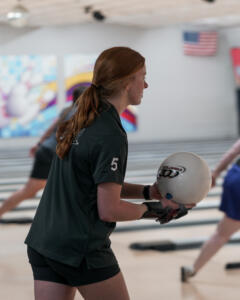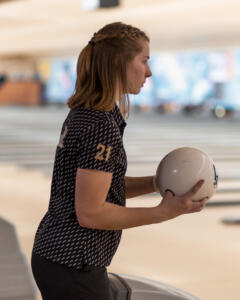NASHVILLE, Tenn. — In the excitement and intensity of Vanderbilt’s road to the 2023 NCAA Championship, the focus, naturally, was on those bowlers that were in the midst of the fray. Very few among us were thinking about the two talented Commodores that had been relegated to the sidelines with various physical ailments. Their absence from the rotation was felt but fortunately, Vanderbilt’s roster depth prevailed.

Those two Dores, Kailee Channell and Paige Peters, are back, rarin’ to go as their junior year beckons. While the issues that sidelined them differ to a degree, their paths back and their attitudes are remarkably similar.
Channell became the program’s first Tennessean when she chose Vanderbilt two years ago. (Her older sister, Ashley, was a mainstay at Louisiana Tech). Kailee shined when her opportunities presented themselves during her first season. Bigger things were anticipated entering her sophomore year when she began experiencing hip pain, a not-so-uncommon malady for serious bowlers. Weighing her options, Channell chose surgery.
“I had a torn hip labrum,” she said in her gentle, southern tone. “They went in, pulled the hip joint out of place to repair the tear and put me back together.”
Sounds like fun. The surgery put her on crutches for nearly a month and then the long road of rehabilitation began in earnest.
“I did rehab until August (2023) when I came back to campus,” she explained. “When we first started, we were trying to keep my leg moving. I couldn’t walk. And since I was hurt for so long, I had to learn how to walk again. I wasn’t distributing my weight properly and I had to learn how to do that again. I was mainly focused on rebuilding the muscles.”
Channell came back carefully, starting in May by throwing balls with no steps and one step; she didn’t get into full approaches until the end of June or early July. She now estimates she is about 75% back to her normal game.
“Somedays everything is working good and other days I can definitely tell I’ve taken time off so I’m relearning how to get everything working together again,” she said.
Missing the first-hand intensity of the memorable season was a tough one for Channell to take.

“It was hard,” she remembered. “In the fall I didn’t get to travel, and it was different having to watch us compete on a computer screen. In the spring, it was hard because I wanted to be able to bowl and participate. It became more trying to find how I could support everybody and be the best cheerleader for everybody. Leading up to the national championship I had those moments where I was just trying to do everything I could to keep everyone calm because I knew I was the one person that had no chance to bowl. My role was feeling everyone else’s emotions.”
Today, she reports that she is “definitely taking care of and listening to [her] body.” There are still days when that pesky pain persists, but she can see progress. Her goal heading into this season is simply to stay healthy and when given opportunities, make the most of them.
Peters, likewise, had a frustrating sophomore campaign despite repeating as a third-team All-American. She had a monster freshman season, earning National Rookie of the Year honors and performing at a high enough level that Mabel Cummins was actually moved into leadoff, allowing the Toms River, New Jersey, product to handle anchor duties.
Peters learned last October she had torn a hip labrum (sound familiar?) and that was complicated by a tight IT band on her other side. Then as the spring schedule began, she came down with patella tendonitis in her left knee, which went nicely with her bad right hip. Wonderful.
“Both sides of my legs were not communicating with each other,” she said. “So, if one side hurt I would overcompensate and there would be a domino effect. Your legs are where you get most of the power in your shot; you need a stable foundation, and I didn’t have one.”
If that wasn’t bad enough, Peters was hit by various illnesses five months in a row! Her general health would have had to improve to be called crummy.
She didn’t opt for surgery. She basically chose to rest, something she had seldom done in recent years as she had bowled national and international summer tournaments representing Junior Team USA.
 “I went to see a physical therapist and picked up some rehab techniques,” she said. “I didn’t like them too much in the beginning, but we ended up turning them into something I could enjoy, especially as I realized how much they were helping. They were mostly about gaining strength and lengthening the tendon in my knee, which was too short. I definitely enjoy going to the gym and working out, so I was able to incorporate the exercises in the gym as well as the rehab sessions. It helped doing them in both places, it gave them more time.”
“I went to see a physical therapist and picked up some rehab techniques,” she said. “I didn’t like them too much in the beginning, but we ended up turning them into something I could enjoy, especially as I realized how much they were helping. They were mostly about gaining strength and lengthening the tendon in my knee, which was too short. I definitely enjoy going to the gym and working out, so I was able to incorporate the exercises in the gym as well as the rehab sessions. It helped doing them in both places, it gave them more time.”
Like Channell, Peters was unselfish in her role as a cheerleader during last spring’s title push.
“No matter what you are doing—If you are bowling or just watching—you are all together as a team,” she said with conviction. “The goal is to do it together. I feel like my role was to root for my friends. We are doing this together and we are watching and cheering you on. I don’t think it ever crossed my mind that I wasn’t throwing a ball. At different points there are different jobs for teammates and my role then was to cheer for my teammates. I don’t think about myself in those situations.”
Also like Channell, Peters says her hopes for the season begin with staying healthy.
If these two Commodores can accomplish that goal, an already powerful Vanderbilt team will be just that much deeper—and stronger.
Vanderbilt’s season begins Friday at Wisconsin-Whitewater’s Warhawk Classic.

